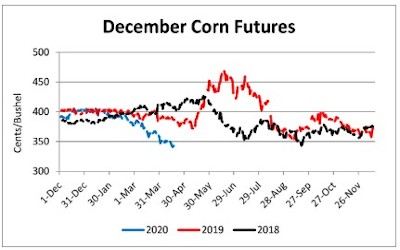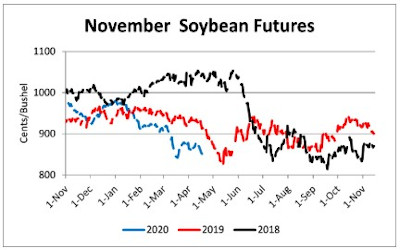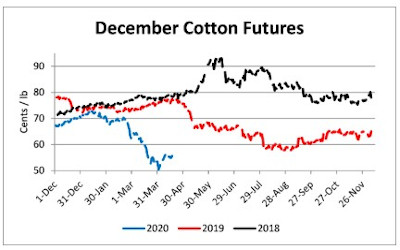Cash prices dropped for all four commodities this week as the COVID-19 economic disruption continues to adversely affect agricultural commodity prices in Tennessee. Commodity prices are now well below breakeven levels for most row crop producers in Tennessee. For example, if you use 2019 Tennessee state average yields for corn (177 bu/acre), cotton (1,136 lb/acre), soybeans (47 bu/acre), and wheat (67 bu/acre) and today’s average cash prices (corn-$3.27; cotton-50.19; soybeans-$8.53, and wheat-$5.14) producers gross revenue is projected at: $580/acre (corn), $570/acre (cotton), $400/acre (soybeans), and $345/acre (wheat). Removing cash rents or return to land of $100-$200+/acre and the ability to cover inputs, loan payments, machinery expenses, and overhead is greatly diminished. Without government payments or an improvement in prices between now and harvest, even with average to above average yields, profit margins will be slim or negative.
One factor that row crop producers have on their side is time. Crops held in storage can remain in storage and crops being planted will have until at least harvest for prices to rebound (no guarantee, just potential) and partially mitigate current projected losses. By contrast, dairy farmers do not have time to recoup losses. Dumped milk or reduced bi-weekly/monthly revenue is felt immediately and without government payments or insurance indemnities is not recoverable.
Payments from existing programs (crop insurance, ARC/PLC) are unlikely to make crop producers whole. Details of any additional support to crop producers will likely be released by USDA after spring planting is completed. This will ensure any program payments do not disrupt planting intentions and give policy makers more time to assess the damage caused by the COVID-19 pandemic. For now the USDA’s focus, as it should be, is on more immediate concerns (fruit, vegetable, dairy, ethanol, and livestock) where time is of the utmost importance. Let’s hope that the money gets to those in the agricultural community that are experiencing the most immediate impact.

Corn
Ethanol production for the week ending April 10 was 0.570 million barrels per day, down 102,000 barrels from the previous week. Ethanol stocks were 27.469 million barrels, up 0.378 million barrels compare to last week. Corn net sales reported by exporters for April 3-9 were down compared to last week with net sales of 35.7 million bushels for the 2019/20 marketing year and 2.5 million bushels for the 2020/21 marketing year. Exports for the same time period were down 5% from last week at 48.1 million bushels. Corn export sales and commitments were 79% of the USDA estimated total exports for the 2019/20 marketing year (September 1 to August 31) compared to the previous 5-year average of 85%. Across Tennessee, average corn basis (cash price-nearby futures price) weakened at Memphis, Northwest Barge Points, and Upper-middle Tennessee and strengthened at Northwest Tennessee. Overall, basis for the week ranged from 11 under to 27 over, with an average of 7 over the May futures at elevators and barge points. May 2020 corn futures closed at $3.22, down 9 cents since last Friday. For the week, May 2020 corn futures traded between $3.17 and $3.34. May/Jul and May/Dec future spreads were 7 and 21 cents. July 2020 corn futures closed at $3.26, down 7 cents since last Friday.

Nationally the Crop Progress report estimated corn planting at 3% compared to 3% last year and a 5-year average of 4%. In Tennessee, the Crop Progress report estimated corn planted at 12% compared to 1% last week, 14% last year, and a 5-year average of 12%. In Tennessee, new crop cash corn contracts ranged from $3.16 to $3.49. December 2020 corn futures closed at $3.43, down 7 cents since last Friday. Downside price protection could be obtained by purchasing a $3.50 December 2020 Put Option costing 28 cents establishing a $3.22 futures floor.

Soybeans
Net sales reported by exporters were down compared to last week with net sales of 9.0 million bushels for the 2019/20 marketing year and 2.2 million bushels for the 2020/21 marketing year. Exports for the same period were up 45% compared to last week at 19.3 million bushels. Soybean export sales and commitments were 78% of the USDA estimated total annual exports for the 2019/20 marketing year (September 1 to August 31), compared to the previous 5-year average of 94%. Average soybean basis strengthened or remained unchanged at Memphis, Northwest Barge Points, Northwest, and Upper-middle Tennessee. Basis ranged from 10 under to 32 over the May futures contract at elevators and barge points. Average basis at the end of the week was 17 over the May futures contract. May 2020 soybean futures closed at $8.32, down 31 cents since last Friday. For the week, May 2020 soybean futures traded between $8.31 and $8.70. May/Jul and May/Nov future spreads were 10 and 19 cents. July 2020 soybean futures closed at $8.42, down 29 cents since last Friday. May soybean-to-corn price ratio was 2.58 at the end of the week.

In Tennessee, new crop soybean cash contracts ranged from $8.20 to $8.91. Nov/Dec 2020 soybean-to-corn price ratio was 2.48 at the end of the week. November 2020 soybean futures closed at $8.51, down 24 cents since last Friday. Downside price protection could be achieved by purchasing an $8.60 November 2020 Put Option which would cost 44 cents and set an $8.16 futures floor.

Cotton
Net sales reported by exporters were down compared to last week with net sales cancellations of 183,800 bales for the 2019/20 marketing year and net sales of 71,800 bales for the 2020/21 marketing year. Exports for the same time period were down 36% compared to last week at 312,000 bales. Upland cotton export sales were 109% of the USDA estimated total annual exports for the 2019/20 marketing year (August 1 to July 31), compared to the previous 5-year average of 97%. Delta upland cotton spot price quotes for April 16 were 49.04 cents/lb (41-4-34) and 51.29 cents/lb (31-3-35). Adjusted World Price (AWP) increased 0.49 cents to 44.78 cents. May 2020 cotton futures closed at 52.77 cents, down 1.6 cents since last Friday. For the week, May 2020 cotton futures traded between 51.91 and 54.55 cents. May/Jul and May/Dec cotton futures spreads were 0.09 cents and 2.49 cents. July 2020 cotton futures closed at 52.86 cents, down 1.54 cents since last Friday.

Nationally, the Crop Progress report estimated cotton planted at 9%, compared to 7% last week, 7% last year, and a 5-year average of 6%. December 2020 cotton futures closed at 55.26, down 0.7 cents since last Friday. Downside price protection could be obtained by purchasing a 56 cent December 2020 Put Option costing 5.04 cents establishing a 50.96 cent futures floor.

Wheat
Wheat net sales reported by exporters were up compared to last week with net sales of 6.6 million bushels for the 2019/20 marketing year and 15.4 million bushels for the 2020/21 marketing year. Exports for the same time period were up 90% from last week at 26.5 million bushels (a marketing year high). Wheat export sales were 94% of the USDA estimated total annual exports for the 2019/20 marketing year (June 1 to May 31), compared to the previous 5-year average of 102%. May 2020 wheat futures closed at $5.33, down 23 cents since last Friday. May 2020 wheat futures traded between $5.24 and $5.64 this week. May wheat-to-corn price ratio was 1.66. May/Jul and May/Sep future spreads were 0 and 5 cents.

Nationally the Crop Progress report estimated winter wheat condition at 62% good-to-excellent and 10% poor-to-very poor; winter wheat headed at 6% compared to 5% last year and a 5-year average of 7%; and spring wheat planted at 5% compared to 2% last year and a 5-year average of 9%. In Tennessee, winter wheat was estimated at 64% good-to-excellent and 3% poor-to-very poor; winter wheat jointing at 73% compared to 42% last week, 67% last year, and a 5-year average of 66% and winter wheat headed at 6% compared to 4% last year and a 5-year average of 5%. In Tennessee, June/July 2020 cash contracts ranged from $5.14 to $5.76. July 2020 wheat futures closed at $5.33, down 24 cents since last Friday. Downside price protection could be obtained by purchasing a $5.35 July 2020 Put Option costing 26 cents establishing a $5.09 futures floor. July wheat-to-corn price ratio was 1.62. September 2020 wheat futures closed at $5.38, down 23 cents since last Friday.

Source : tennessee.edu